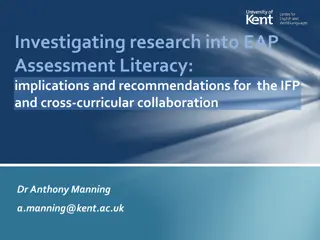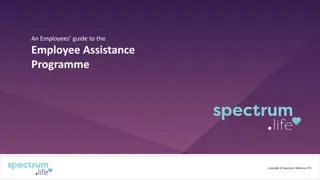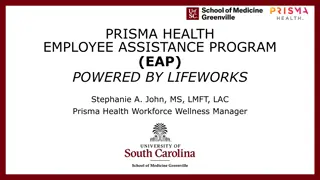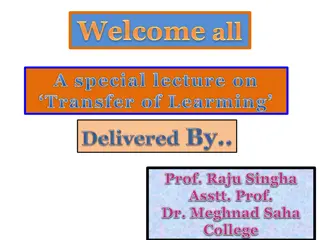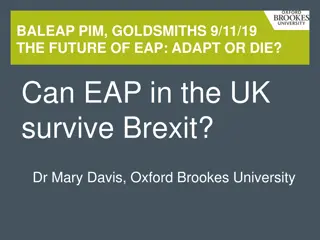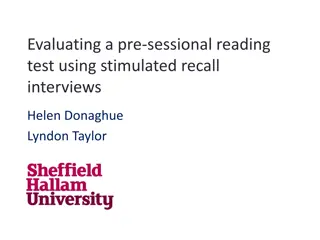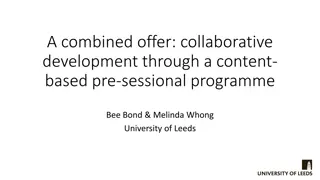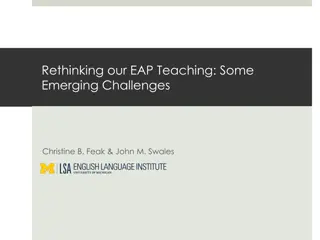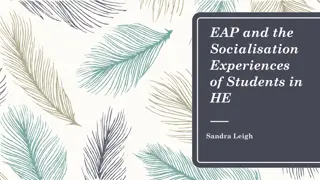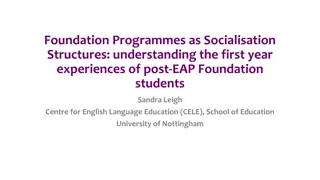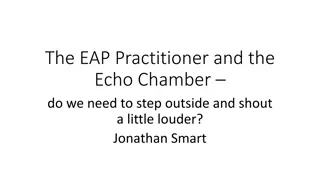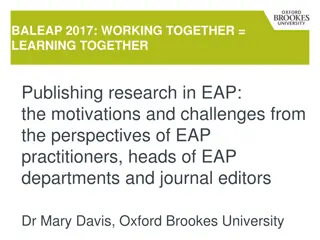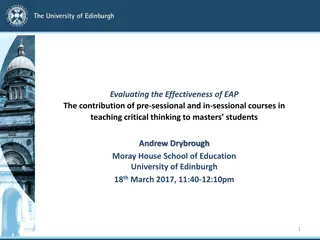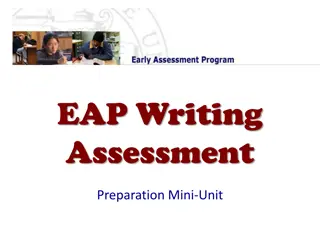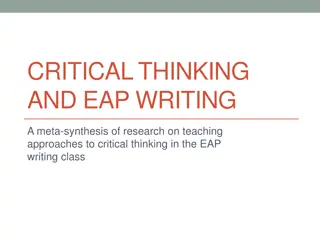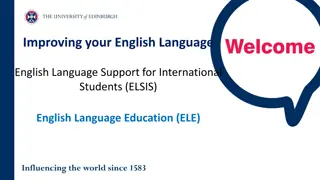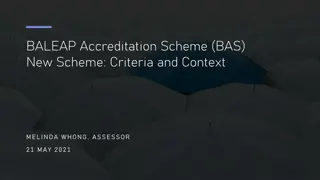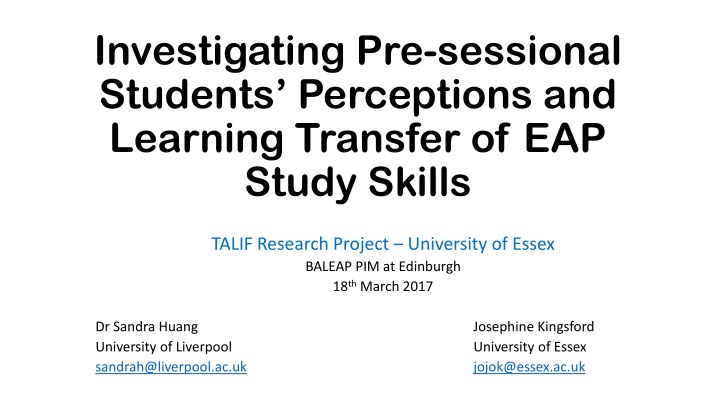
Enhancing EAP Study Skills Transfer for Pre-sessional Students
Explore how to design pre-sessional courses to facilitate effective learning transfer of EAP study skills, based on perceptions of students, teachers, and lecturers. Investigate factors influencing skills transfer and ways to stimulate it in different academic contexts.
Download Presentation

Please find below an Image/Link to download the presentation.
The content on the website is provided AS IS for your information and personal use only. It may not be sold, licensed, or shared on other websites without obtaining consent from the author. If you encounter any issues during the download, it is possible that the publisher has removed the file from their server.
You are allowed to download the files provided on this website for personal or commercial use, subject to the condition that they are used lawfully. All files are the property of their respective owners.
The content on the website is provided AS IS for your information and personal use only. It may not be sold, licensed, or shared on other websites without obtaining consent from the author.
E N D
Presentation Transcript
Investigating Pre-sessional Students Perceptions and Learning Transfer of EAP Study Skills TALIF Research Project University of Essex BALEAP PIM at Edinburgh 18thMarch 2017 Dr Sandra Huang University of Liverpool sandrah@liverpool.ac.uk Josephine Kingsford University of Essex jojok@essex.ac.uk
Background Pre-sessional teaching In-sessional Support classes Pre-sessional Materials Design 03/04/2025 2
Pre-sessional Perceptions Subject teachers perceptions Pre-sessional students perceptions EAP tutors perceptions 03/04/2025 3
Subject Lecturers perceptions EAP teacher s observation a. word by word translation, no holistic overview; a. no preparation; not doing set reading b. lack of English b. Comments made by lecturer were concerned lack of argumentation, structure, critical thinking, i.e. lecturer made EAP comments c. No confidence in speaking in seminars, but able to speak to EAP tutors after seminars c. lack of participation in seminars and tutorials, i.e. students being passive = lazy d. did not know how to start an assignment d. Not knowing how to find academic sources 03/04/2025 4
Subject Lecturers perceptions EAP teacher s observation a. word by word translation, no holistic overview; a. no preparation; not doing set reading b. lack of English ACADEMIC WRITING SKILLS c. lack of participation in seminars and tutorials, i.e. students being passive = lazy ACADEMIC SPEAKING SKILLS d. did not know how to start an assignment ACADEMIC READING SKILLS b. Comments made by lecturer were concerned lack of argumentation, structure, critical thinking, i.e. lecturer made EAP comments c. No confidence in speaking in seminars, but able to speak to EAP tutors after seminars d. Not knowing how to find academic sources 03/04/2025 RESEARCH SKILLS 5
Transference of Study Skills James (2008; 2010; 2014) Not inevitable Often delayed The factors influencing skills transfer Multi- dimentional Students perception of task and context similarity is one important element stimulating skill transfer in another setting. 03/04/2025 6
Transference of Study Skills How can a pre-sessional course be designed to stimulate learning transfer? 03/04/2025 7
The Aims of Materials Design To develop critical reading skills To familiarise students with reading academic journal articles / texts To encourage a holistic reading approach (i.e. for meaning and purposes) To provide a link between PS material and students future assignment demands, i.e. an awareness of usefulness and transferability of skills learnt on the PS 03/04/2025 8
The Three Phases of the Academic Projects A summary of a research article A critical review of two research articles An academic essay of own chosen topic 03/04/2025 9
Findings Assignment Types Essays Critical reviews Group discussions Oral presentations Reports Research proposals Progress reports (PhDs) 03/04/2025 10
Findings Challenges in PG studies Critical thinking Critical evaluation (of viewpoints), i.e. finding own opinions Unable to understand assignment briefs How to start Difficulties in assignments relating theory to essay structure Finding suitable sources , e.g. using the keyword method 03/04/2025 11
Findings The Most Useful Skills Note-taking Essay organisation Referencing How to avoid plagiarism Feedback analysis Critical thinking most things are learned [from] the Project the Project class is the most useful that course support your study now 03/04/2025 12
Findings We need more! Academic / subject-specific reading To study on a pre-sessional course with students from the same subject / department Familiarisation with different types of assignments, e.g. research reports, research proposals, etc. 03/04/2025 13
I think if there are different kind, many kind of different project, it would be better. Not just the critical review. Because you know your project course just two assignment, one is critical review, one is essay. But when I study in Sociology department now, there are many, many kind of assignments, reports, the proposal, the research design proposal and review, and many, many kind. But some of them, some of the assignments we never heard it before. Sometimes it s difficult for students. The teacher should teach more kind of assignments. 03/04/2025 14
Conclusion Near Transfer 1.The students perception of task and context similarity crucial in skill transfer 2.The students anticipation and awareness of applying study skills needs to be increased 03/04/2025 15
Conclusion Near Transfer In order to facilitate study skills transfer, James (2014:11) suggests that educators may benefit from placing at least some emphasis on near transfer; although EAP instruction is already often designed to be similar to target situations (e.g. students other courses), near transfer might be emphasised by ensuring these similarities reflect as many dimensions of the transfer taxonomy as possible. James (ibid.) also points out that EAP educators should, however, be cautious about expecting transfer when target situations differ from EAP instructions in numerous ways. 03/04/2025 16
References James, M. A. (2008). The influence of perceptions of task similarity/difference on learning transfer in second language writing . Written Communication 25(1): 76- 103. James, M. A. (2010). An investigation of learning transfer in English-for-general- academic-purposes writing instruction . Journal of Second Language Writing 19: 183-206. James, M. A. (2014). Learning transfer in English-for-academic-purposes contexts: a systematic review of research . Journal English for Academic Purposes 14: 1-13. Moore, T. & Morton, J. (2005). Dimensions of difference: a comparison of university writing and IELTS writing . Journal English for Academic Purposes 4: 43- 66. Storch, N. & Tapper, J. (2009). The impact of an EAP course on postgraduate writing . Journal of English for Academic Purposes 8: 207-223. Terraschke, A. & Wahid, R. (2011). The impact of EAP study on the academic experiences of international postgraduate students in Australia . Journal of English for Academic Purposes 10: 173-182. 03/04/2025 17


